How to Identify B Series Ring Gear Size
In the Gearing
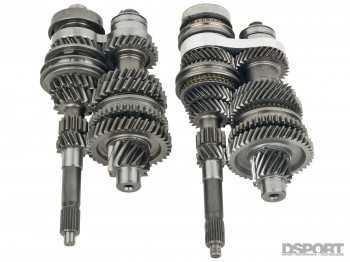 The inter-gear ratios of the manual dictate the required width of the engine's powerband for top dispatch. The upshift inter-gear ratio dictates where the engine's RPM will autumn when shifted from gear to gear. The 1-2-upshift inter-gear ratio is calculated by dividing the gear ratio of 2nd divided by the gear ratio of First. In the case of the Albins 4-speed drag ratio gearset that we are using, 2nd gear is a 2.00:1 ratio while first gear is a three.00:one ratio. This upshift inter-gear ratio is therefore 0.667. Multiplying this upshift inter-gear ratio of 0.667 and the shift RPM of 10,500 RPM produces 7,000 RPM. Hence, the 1-2 shift at 10,500RPM drops the engine speed to seven,000 RPM as second gear is started. Third has a 1.390:1 gear ratio, so the upshift inter-gear ratio equates to .695. The .695 inter-gear ratio drops the RPM from x,500 RPM in Second to about 7,300 RPM to start third gear. Quaternary gear has a 1.09:ane ratio which produces a 0.784 ratio for the three-iv upshift. Shifting from 3rd at x,500 RPM drops the engine speed to about 8,250 RPM for the start of Fourth. Based on the gear ratios delivered by the Albins gearset, the ideal powerband would start at 7,000 RPM and proceed through ten,500 RPM for power commitment to be optimized in every forrad gear. Since this is a FWD vehicle and traction is limited, a power ring that starts a piffling later (at a college RPM) may not impede performance significantly equally simply so much torque tin can be delivered to the ground before the tires break loose. The corporeality of time spent in Second gear is probable to be simply a couple seconds, and so it's the powerband required for peak performance in Tertiary and Quaternary that our most critical. For Tertiary gear, our engine's powerband starts about 700 RPM subsequently than the platonic. As such, nosotros'll likely have to make some changes to start our powerband a scrap earlier in club to realize the quickest performance on the strip.
The inter-gear ratios of the manual dictate the required width of the engine's powerband for top dispatch. The upshift inter-gear ratio dictates where the engine's RPM will autumn when shifted from gear to gear. The 1-2-upshift inter-gear ratio is calculated by dividing the gear ratio of 2nd divided by the gear ratio of First. In the case of the Albins 4-speed drag ratio gearset that we are using, 2nd gear is a 2.00:1 ratio while first gear is a three.00:one ratio. This upshift inter-gear ratio is therefore 0.667. Multiplying this upshift inter-gear ratio of 0.667 and the shift RPM of 10,500 RPM produces 7,000 RPM. Hence, the 1-2 shift at 10,500RPM drops the engine speed to seven,000 RPM as second gear is started. Third has a 1.390:1 gear ratio, so the upshift inter-gear ratio equates to .695. The .695 inter-gear ratio drops the RPM from x,500 RPM in Second to about 7,300 RPM to start third gear. Quaternary gear has a 1.09:ane ratio which produces a 0.784 ratio for the three-iv upshift. Shifting from 3rd at x,500 RPM drops the engine speed to about 8,250 RPM for the start of Fourth. Based on the gear ratios delivered by the Albins gearset, the ideal powerband would start at 7,000 RPM and proceed through ten,500 RPM for power commitment to be optimized in every forrad gear. Since this is a FWD vehicle and traction is limited, a power ring that starts a piffling later (at a college RPM) may not impede performance significantly equally simply so much torque tin can be delivered to the ground before the tires break loose. The corporeality of time spent in Second gear is probable to be simply a couple seconds, and so it's the powerband required for peak performance in Tertiary and Quaternary that our most critical. For Tertiary gear, our engine's powerband starts about 700 RPM subsequently than the platonic. As such, nosotros'll likely have to make some changes to start our powerband a scrap earlier in club to realize the quickest performance on the strip.
Boost Curve vs. Power Curve
For the current combination, the engine'south gradual heave curve is directly affecting the torque and power curve shapes of the engine. While the i.25 A/R turbine housing is likely the best option for peak power, a smaller 1.10 A/R or i.00 A/R turbine housing would permit the engine to reach its target boost pressure (40-42 psi) at a lower RPM. This will likely augment the powerband of the engine while possibly trading off some peak power output due to higher exhaust backpressure. If the engine was already at the targeted heave pressure by 7,000 RPM and nosotros still required a shift in the power and torque curves, swapping to a shorter duration camshaft could help shift the curves to the left (producing more ability and torque sooner while potentially losing some power and torque at the very top finish).
Clutch Performer
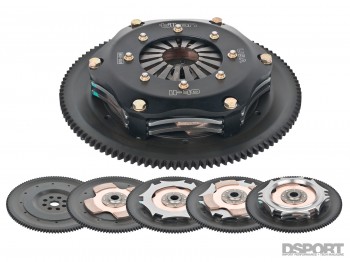 High torque output, excellent traction, high vehicle weights and high engine RPMs are some of the conditions that make clutch design difficult. In the case of our drag Borough, the vehicle weight is relatively low at 2,450 pounds with driver simply the traction capabilities of the FWD on slicks is about on-par with an all-wheel-drive vehicle on street tires. Hence the amount of available traction is quite substantial and that means a good amount of load on the driveline will exist produced before wheelspin occurs. As for the engine, 620 lb-ft of torque is also quite substantial. Combine these atmospheric condition with the fact that the clutch needs to properly engage and release at 10,500 RPM and the field of potential players gets dwindled down to ii or three clutch systems that can do it right. Having bang-up success in the past with the custom quad disc, carbon-carbon clutch used on our Project R33, we decided to look to Tilton for a solution. Thanks to the popularity of the Honda B-series engine, Tilton offers an off-the-shelf solution. The Tilton Cerametallic Clutch Flywheel Associates (CFA) for the B-series is built effectually a billet-steel flywheel with integral gear. The integral ring gear eliminates a potential betoken of failure found on flywheels that have a pressured or welded ring gear. The billet steel flywheel mounts the 7.25-inch twin-plate OT-series clutch system to the engine. This clutch arrangement uses two 4-pad cerametallic clutch discs along with the Tilton "GG" pressure plate. The 4-pad discs have a lower inertia than full-circle discs for quicker shifting. Torque capacity is rated at 840 lb-ft (about 35-percent above our engine torque output, providing a dainty factor of safety). The entire clutch system and flywheel assembly weighs just xviii.6 pounds. To reduce pedal endeavour, better modulation and eliminate the problems that occur in the factory clutch hydraulics, a Honda hydraulic release bearing kit is also available. The kit provides the hydraulic release begetting, a Tilton ¾-inch bore clutch master cylinder and the necessary hardware and lines for the conversion. To reduce shock loads to the driveline, nosotros likewise installed a Tilton flow control valve. The valve regulates the flow of hydraulic fluid back to the master cylinder when the clutch pedal is released from the flooring and is traveling back to its regular position. 3 different orifices let tuning for just the proper amount of "clutch riding" on launch and between shifts for minimal driveline shock.
High torque output, excellent traction, high vehicle weights and high engine RPMs are some of the conditions that make clutch design difficult. In the case of our drag Borough, the vehicle weight is relatively low at 2,450 pounds with driver simply the traction capabilities of the FWD on slicks is about on-par with an all-wheel-drive vehicle on street tires. Hence the amount of available traction is quite substantial and that means a good amount of load on the driveline will exist produced before wheelspin occurs. As for the engine, 620 lb-ft of torque is also quite substantial. Combine these atmospheric condition with the fact that the clutch needs to properly engage and release at 10,500 RPM and the field of potential players gets dwindled down to ii or three clutch systems that can do it right. Having bang-up success in the past with the custom quad disc, carbon-carbon clutch used on our Project R33, we decided to look to Tilton for a solution. Thanks to the popularity of the Honda B-series engine, Tilton offers an off-the-shelf solution. The Tilton Cerametallic Clutch Flywheel Associates (CFA) for the B-series is built effectually a billet-steel flywheel with integral gear. The integral ring gear eliminates a potential betoken of failure found on flywheels that have a pressured or welded ring gear. The billet steel flywheel mounts the 7.25-inch twin-plate OT-series clutch system to the engine. This clutch arrangement uses two 4-pad cerametallic clutch discs along with the Tilton "GG" pressure plate. The 4-pad discs have a lower inertia than full-circle discs for quicker shifting. Torque capacity is rated at 840 lb-ft (about 35-percent above our engine torque output, providing a dainty factor of safety). The entire clutch system and flywheel assembly weighs just xviii.6 pounds. To reduce pedal endeavour, better modulation and eliminate the problems that occur in the factory clutch hydraulics, a Honda hydraulic release bearing kit is also available. The kit provides the hydraulic release begetting, a Tilton ¾-inch bore clutch master cylinder and the necessary hardware and lines for the conversion. To reduce shock loads to the driveline, nosotros likewise installed a Tilton flow control valve. The valve regulates the flow of hydraulic fluid back to the master cylinder when the clutch pedal is released from the flooring and is traveling back to its regular position. 3 different orifices let tuning for just the proper amount of "clutch riding" on launch and between shifts for minimal driveline shock. 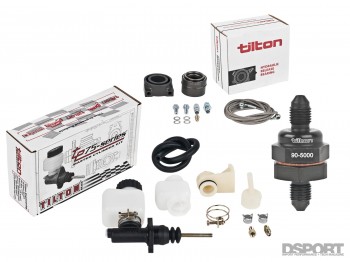
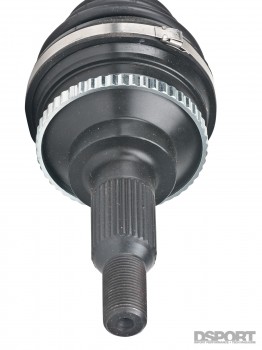
Transmission Gear Ready
[pullquote]THE Transmission'Southward CLOSE-RATIO GEARING PROVIDES LESS RPM Drop PER GEAR THAN Whatsoever FACTORY-Bachelor GEARSETS[/pullquote]To find a proper gearset for the B-series transmission, nosotros had to go over and downward under. Unfortunately, nosotros went over what nosotros originally planned on spending equally the gearset retails for well-nigh $half-dozen,800 (due in function to our weak U.South. dollar). We went "down under" as nosotros couldn't find anyone in the Northern Hemisphere with a proven solution. Located in Victoria, Australia, Albins Performance Transmissions offers a Honda B-series dog-engagement gear gear up for drag racing applications. Designed to fit in the factory B-series transmission case, this close-ratio gear set is built from ultra high-strength barracks blend steel. Using helical cutting gears, dissonance is reduced (compared to direct cut gears) while case deflection is better accommodated. A handcuff caryatid replaces fifth gear with the installation of the system. The gearset's dog-engagement removes the fragile sychros out of the equation and allows for faster shifting. The manual's close-ratio gearing provides less RPM drop per gear than whatever factory-available gearsets for the B-serial. On all of the factory Honda B-serial transmissions, the RPM from a ten,500 RPM shift out of Get-go, drops the RPM to half dozen,175 RPM (6,850 RPM on Del Sol trans). With the Albins gearset, five different final drive ratios are available. We opted for the 4.09:one final drive which yields an effective four.46:ane final drive ratio in Fourth gear. Estimating 5.0-percentage of tire-peak growth on the slick, 10,500 RPM in Fourth would be about 180 MPH. Based on our power-to-weight ratio, nosotros should hitting about 176-178MPH at the traps.
Pro-Level Axles
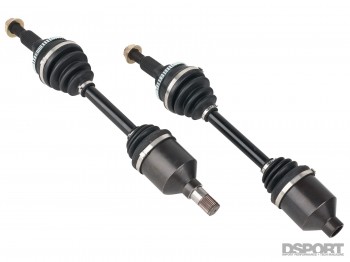
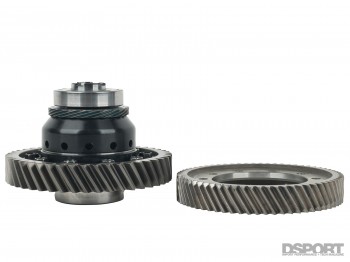 As Honda drag racers continued to push the envelope on power output, the limits of the 27-spline differential and axle setup somewhen became apparent. To accost the needs for additional ability handling, The Driveshaft Shop engineered a Pro-Level 28-spline axle and differential solution. The 28-spline axles are forty-percent larger at the differential and intermediate shafts. On the outers, 33-spline CV's handle all the power that can be delivered to them. The Pro-Level solution requires either a 28-spline spool or 28-spline limitedslip differential. Nosotros opted for the LSD and also had the ABS rings installed so that our MoTeC engine management system could read the wheel speed at each axle. With a retail price around $3,750, the solution is non a cheap date. However, having axles that won't break on a FWD vehicle is one of the best ways to help keep the vehicle from hitting a wall.
As Honda drag racers continued to push the envelope on power output, the limits of the 27-spline differential and axle setup somewhen became apparent. To accost the needs for additional ability handling, The Driveshaft Shop engineered a Pro-Level 28-spline axle and differential solution. The 28-spline axles are forty-percent larger at the differential and intermediate shafts. On the outers, 33-spline CV's handle all the power that can be delivered to them. The Pro-Level solution requires either a 28-spline spool or 28-spline limitedslip differential. Nosotros opted for the LSD and also had the ABS rings installed so that our MoTeC engine management system could read the wheel speed at each axle. With a retail price around $3,750, the solution is non a cheap date. However, having axles that won't break on a FWD vehicle is one of the best ways to help keep the vehicle from hitting a wall.
Wheels and Tires
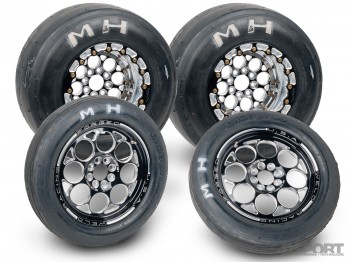 To put the power to the footing, we selected a set of 24.5×ix.5×13-inch K&H Racemaster slicks. M&H Racemaster has been an avid supporter important drag racing since its infancy and its drag slick merely works very well. A set of Weld Wheels Magnum Import Drag wheels of the 13×10 (+0 mm) diverseness with custom OMF Operation beadlocks carries the front rubber. Matching xv×three.5-inch Magnum Import skinnies carry a ready of 24.0×3.6×15-inch skinnies at the rear. Using this "pizza cutter" wheel and tire combination on the rear reduces rolling resistance significantly.
To put the power to the footing, we selected a set of 24.5×ix.5×13-inch K&H Racemaster slicks. M&H Racemaster has been an avid supporter important drag racing since its infancy and its drag slick merely works very well. A set of Weld Wheels Magnum Import Drag wheels of the 13×10 (+0 mm) diverseness with custom OMF Operation beadlocks carries the front rubber. Matching xv×three.5-inch Magnum Import skinnies carry a ready of 24.0×3.6×15-inch skinnies at the rear. Using this "pizza cutter" wheel and tire combination on the rear reduces rolling resistance significantly.
Braking Fast
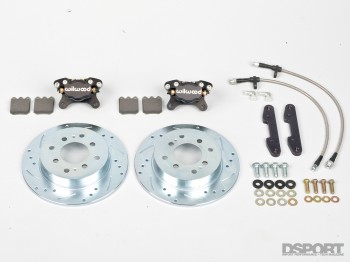 While the right pad and rotor combination tin allow the manufactory brakes to make that single stop at the end of the quarter mile, the mill brakes are extremely heavy for such a job. Fortunately, Fastbrakes.com offers a lightweight elevate brake system for the front end of most Hondas y'all'd want to race. While the standard Fastbrakes.com kit sheds fifteen pounds and uses a unmarried-piston Wilwood caliper, we preferred to give upwards a pound of weight loss and run the optional two-piston Wilwood calipers. The 2-piston calipers offer a bit more braking torque due to the increased piston area while also offering less drag on the brakes due to its design.
While the right pad and rotor combination tin allow the manufactory brakes to make that single stop at the end of the quarter mile, the mill brakes are extremely heavy for such a job. Fortunately, Fastbrakes.com offers a lightweight elevate brake system for the front end of most Hondas y'all'd want to race. While the standard Fastbrakes.com kit sheds fifteen pounds and uses a unmarried-piston Wilwood caliper, we preferred to give upwards a pound of weight loss and run the optional two-piston Wilwood calipers. The 2-piston calipers offer a bit more braking torque due to the increased piston area while also offering less drag on the brakes due to its design.
About the Limit
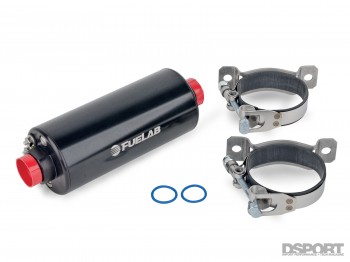 To this point, there appears to be only i item reaching its limit. The Fuelab 41402 Prodigy Fuel Pump is conservatively rated to support 1,300 horsepower on gasoline. This is one bad-ass pump. If we were running race gas or mayhap even running at at lower boost pressure levels, this pump would easily support that number and and then some. However, we are dealing with ii factors that actually limit the horsepower potential of a fuel pump. Commencement, we are running E85 and that requires almost 40 percent more volumetric flow than gasoline for the same power level. Hence, if a particular fuel pump can back up i,300whp on gasoline, it can but back up (1,300/one.iv) or 930 horsepower on E85. Second, nosotros are running a significant amount of boost pressure. Fuel pumps need to run at a base force per unit area plus the amount of boost pressure to deliver the proper corporeality of fuel to the engine. If our base fuel pressure level is 45 psi, running 45 psi of boost force per unit area means that the pump is operating at a head pressure of at least 90 psi (possibly closer to 100 psi to overcome inertial and plumbing equipment losses). Equally pressure level increases, the volume that a pump can supply decreases. In the case of the 41402, the pump can supply roughly 12,000 cc/min of flow at 45 psi or most 7,800 cc/min at flow at 100 psi. Since the fuel pump cannot friction match the needed commitment at 100 psi, fuel pressure drops. To compensate for reaching the flow capacity of the pump at that pressure, the injectors are run at a higher duty cycle to provide a safe A/F ratio. Fortunately, we've come up up with a potential solution that will negate the demand to add together a 2nd pump. We are but planning to upgrade from our current "12-volt" to a "sixteen-volt" battery and alternator setup. Nosotros asked Fuelab to run a test on the 41402 at both thirteen.v volts (the charging/alternator voltage of a "12-volt" system) and at eighteen.0 volts (the charging/alternator voltage of a "16-volt" system). The lab results show that the 41402 goes from delivering 7,820 cc/min of menstruation (at 102psi) at xiii.5 volts to delivering over 11,600 cc/min of menses (at 106 psi) at xviii.0 volts. That's plenty to back up over 1,300 horsepower at the wheels on E85. Equally a side do good, the new "16-volt" arrangement volition as well increase the voltage capacity of the current gyre-on-plug ignition organization. This should further reduce the gamble of misfires and plug fouling.
To this point, there appears to be only i item reaching its limit. The Fuelab 41402 Prodigy Fuel Pump is conservatively rated to support 1,300 horsepower on gasoline. This is one bad-ass pump. If we were running race gas or mayhap even running at at lower boost pressure levels, this pump would easily support that number and and then some. However, we are dealing with ii factors that actually limit the horsepower potential of a fuel pump. Commencement, we are running E85 and that requires almost 40 percent more volumetric flow than gasoline for the same power level. Hence, if a particular fuel pump can back up i,300whp on gasoline, it can but back up (1,300/one.iv) or 930 horsepower on E85. Second, nosotros are running a significant amount of boost pressure. Fuel pumps need to run at a base force per unit area plus the amount of boost pressure to deliver the proper corporeality of fuel to the engine. If our base fuel pressure level is 45 psi, running 45 psi of boost force per unit area means that the pump is operating at a head pressure of at least 90 psi (possibly closer to 100 psi to overcome inertial and plumbing equipment losses). Equally pressure level increases, the volume that a pump can supply decreases. In the case of the 41402, the pump can supply roughly 12,000 cc/min of flow at 45 psi or most 7,800 cc/min at flow at 100 psi. Since the fuel pump cannot friction match the needed commitment at 100 psi, fuel pressure drops. To compensate for reaching the flow capacity of the pump at that pressure, the injectors are run at a higher duty cycle to provide a safe A/F ratio. Fortunately, we've come up up with a potential solution that will negate the demand to add together a 2nd pump. We are but planning to upgrade from our current "12-volt" to a "sixteen-volt" battery and alternator setup. Nosotros asked Fuelab to run a test on the 41402 at both thirteen.v volts (the charging/alternator voltage of a "12-volt" system) and at eighteen.0 volts (the charging/alternator voltage of a "16-volt" system). The lab results show that the 41402 goes from delivering 7,820 cc/min of menstruation (at 102psi) at xiii.5 volts to delivering over 11,600 cc/min of menses (at 106 psi) at xviii.0 volts. That's plenty to back up over 1,300 horsepower at the wheels on E85. Equally a side do good, the new "16-volt" arrangement volition as well increase the voltage capacity of the current gyre-on-plug ignition organization. This should further reduce the gamble of misfires and plug fouling.
The Master Program
The Voltphreaks 16-volt lithium battery and Powermaster 16V alternator take just arrived. As before long equally nosotros get a run a risk, these items volition be installed and the vehicle will exist re-tuned to arrange the increased fuel delivery chapters of the organization. From there, we plan to do some further dyno testing with the smaller 1.x A/R turbine housing. Hopefully, nosotros will also exist able to take a look at some ¼-mile datalogs with the current 1.25 A/R turbine housing in place besides. From in that location, we'll try to determine if a trip to the strip with the smaller A/R turbine housing is warranted. We are also planning to test the effects of varying the plenum volume on the Skunk 2 Ultra-serial intake manifold. Existence able to run consequent 8-second passes reliably may take us in other directions every bit well. We take yet to punch in the suspension to maximize its ability to help the power become to the ground. Nosotros also haven't started playing with custom camshafts to optimize the power curve. There'due south enough to practice and plenty to larn. If you are interested in engine and drag functioning, from a Honda or whatsoever vehicle for that thing, stay tuned. 
Role 1 >>
Function 2 >>
Office three >>
Role five >>
Office vi >>
Role 7 >>
DOWNLOAD HERE
How to Identify B Series Ring Gear Size UPDATED
Posted by: thomastwold1970.blogspot.com
0 commentaires:
Enregistrer un commentaire